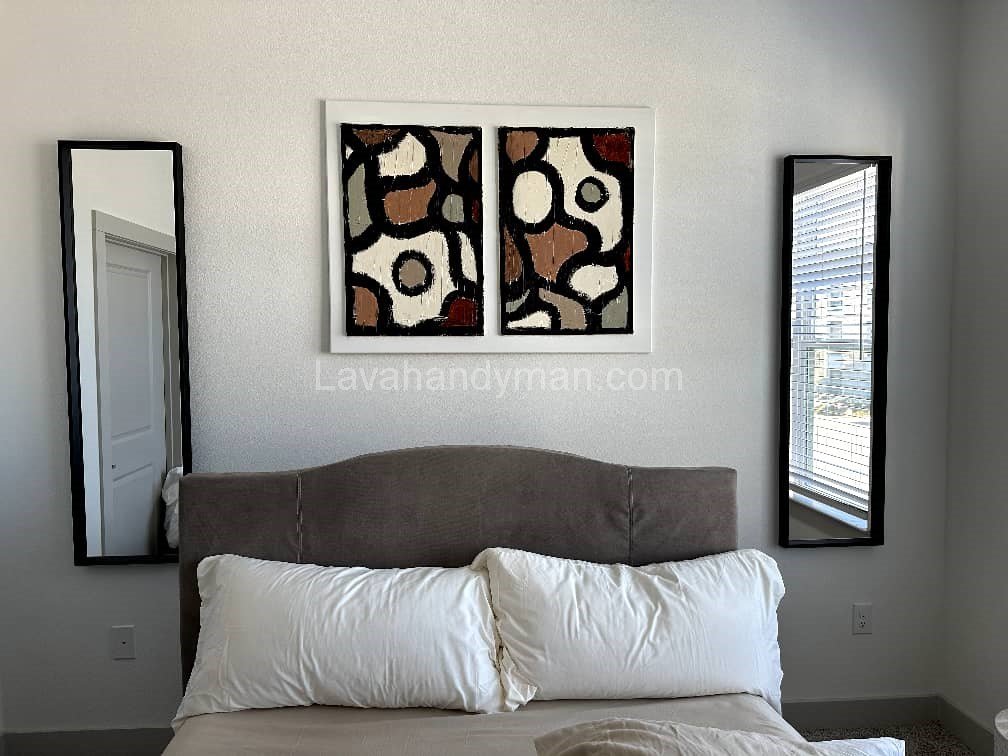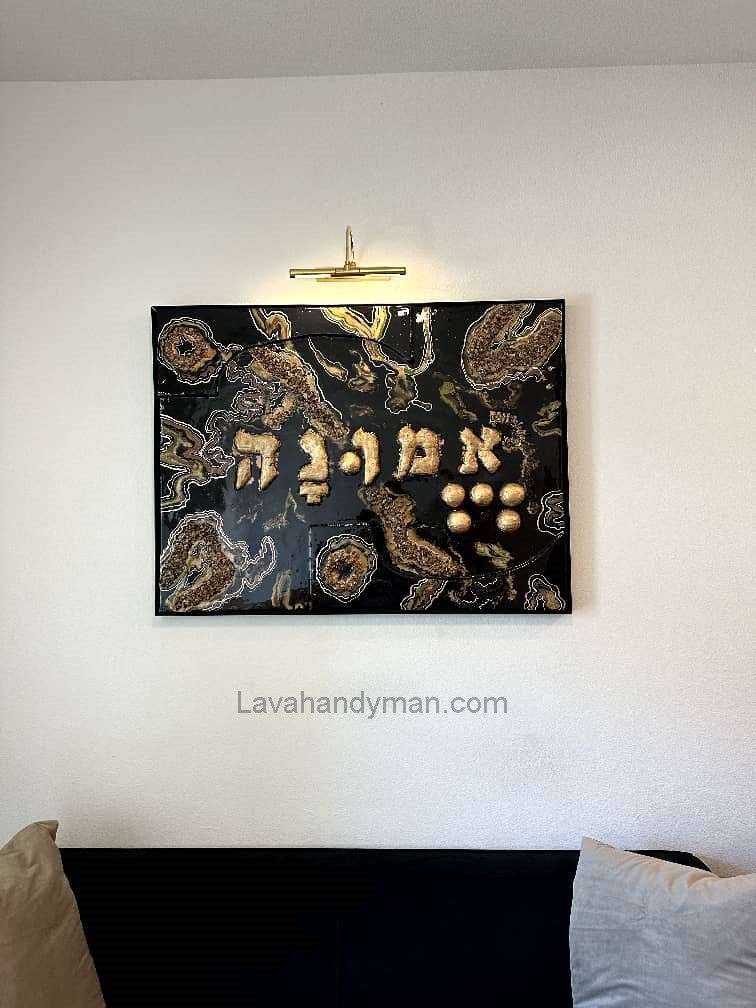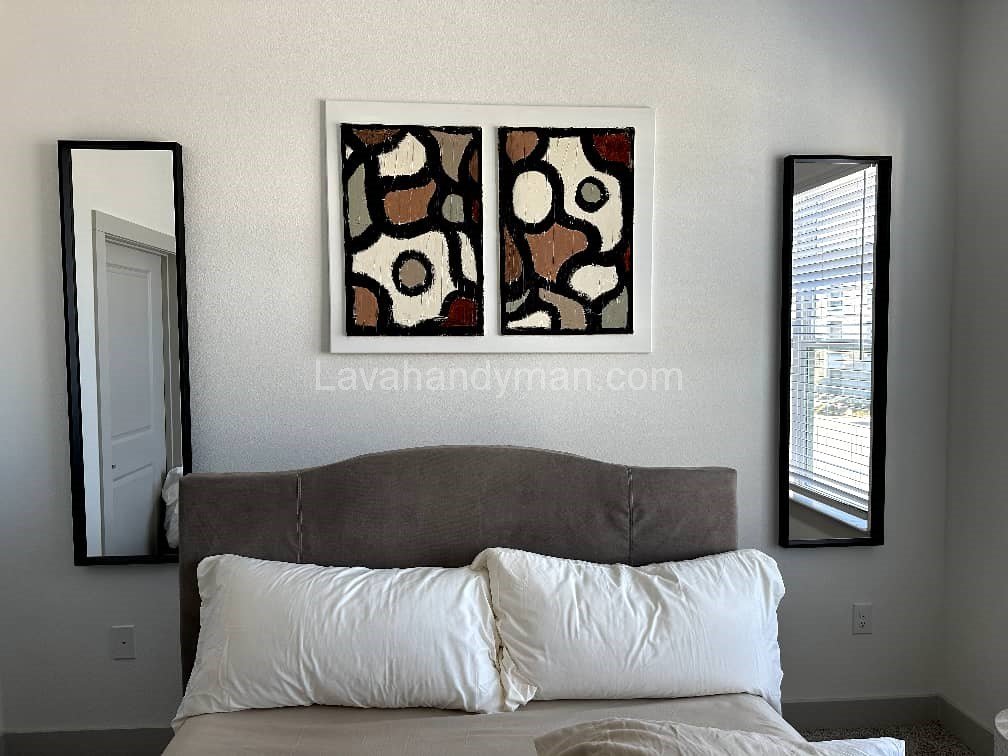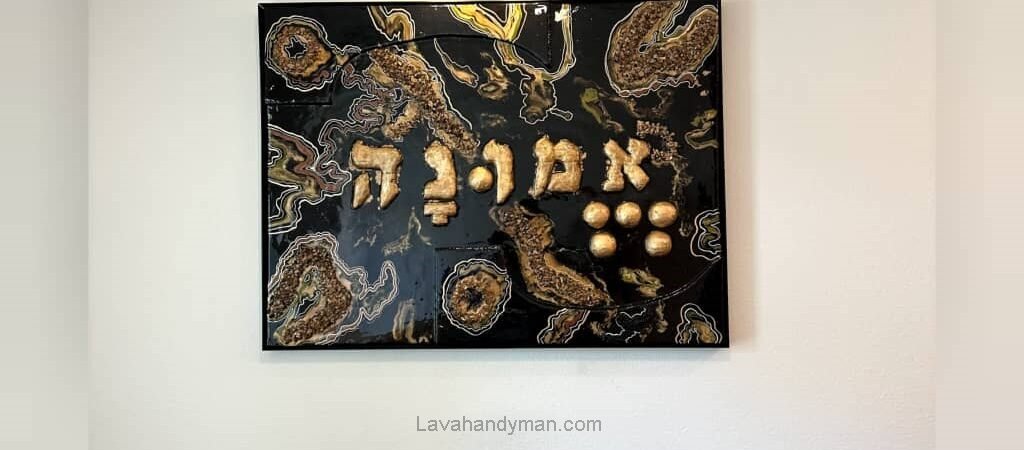Installing Luxury Wall Art with Modern Methods | Guide
Introduction
Luxury and artistic wall art play a crucial role in interior design. Proper installation not only enhances the aesthetic appeal of a space but also prevents damage to both the wall and the artwork. With technological advancements, traditional methods such as nails and screws have been largely replaced by modern solutions, including hidden rails, magnetic mounts, and industrial adhesives. This article provides a comprehensive review of these modern methods, the necessary tools, and technical considerations for professional installation.

1. Understanding Luxury Wall Art
Luxury wall art varies in material and structure:
- Heavy wooden frame paintings: Require high load-bearing capacity and structural support.
- Metal or mixed-material frames: Offer more flexibility and easier installation.
- Frameless modern printed art: Lighter but more susceptible to scratches and damage.
Key characteristics of luxury wall art:
- Significant weight
- Large dimensions
- Sensitive surface prone to damage
- Requires precise leveling for visual appeal
Installing Luxury Wall Art with Modern Methods | Guide
2. Wall Assessment
Before installation, the wall must be structurally evaluated:
- Wall type: Plaster, concrete, MDF, or reinforced concrete
- Surface condition: Flatness, cracks, and moisture
- Load-bearing capacity: Must support the weight of both the artwork and installation hardware
Essential assessment tools:
- Digital level and measuring tape
- Moisture meter
- Test drill and screws
Installing Luxury Wall Art with Modern Methods | Guide
3. Limitations of Traditional Methods
Traditional methods include nails, screws, plugs, and hooks.
Disadvantages:
- Wall damage
- Difficulty achieving precise leveling
- Limited flexibility for repositioning
4. Modern Installation Methods
4.1 Hidden Rail Systems
Metal rails are concealed behind the artwork, allowing easy repositioning.
Advantages:
- Minimal wall perforation
- Easy adjustment of height and position
- High load-bearing capacity
Installing Luxury Wall Art with Modern Methods | Guide
4.2 Magnetic Mounting
Industrial-strength magnets are used between the wall and artwork.
Advantages:
- No screws or drilling required
- Easy repositioning
- High safety for delicate pieces
4.3 Industrial and Double-Sided Adhesives
Advanced adhesives can support heavy weights without mechanical support.
Advantages:
- Quick installation without specialized tools
- No wall damage
- Resistant to moisture and temperature changes
4.4 Smart Sensor-Based Systems
Art pieces are equipped with digital leveling sensors for precise alignment.
Advantages:
- Extremely high accuracy
- Ideal for professional and exhibition environments
5. Specialized Tools
- Digital level
- Adjustable metal rails
- Electric drill and high-load screws
- Industrial-strength magnets
- Epoxy and high-performance polymer adhesives
Installing Luxury Wall Art with Modern Methods | Guide
6. Step-by-Step Installation Guide
- Assess the wall and artwork
- Determine exact placement using a level and measuring tape
- Choose the appropriate method (rail, magnetic, adhesive)
- Prepare the wall (smooth surface and any necessary substructure)
- Install supporting components or rails
- Mount the artwork and adjust precisely with a level
- Verify stability and safety
7. Safety and Maintenance Tips
- Always overestimate the artwork weight for safety
- Heavy pieces should be installed by two people
- Avoid mounting on damp or cracked walls
- Periodically inspect magnetic or adhesive installations to ensure stability
Installing Luxury Wall Art with Modern Methods | Guide
8. Advantages of Modern Methods
| Feature | Traditional | Modern |
|---|---|---|
| Wall damage | High | Minimal or none |
| Repositioning | Difficult | Easy |
| Load capacity | Limited | High |
| Installation accuracy | Moderate | Very high |
Professional Guide to Installing Luxury Wall Art with Various Brackets
Installing Luxury Wall Art with Modern Methods | Guide
Step 1: Assess the Artwork and Wall
Before installation, carefully evaluate the artwork and the wall:
- Artwork Weight: Choose the bracket type and installation method according to the weight.
- Artwork Dimensions: Large pieces may require multiple brackets or a rail system.
- Wall Type:
- Plaster: Use appropriate wall plugs and load-bearing brackets.
- Concrete or Cement: Heavy-duty drill and screws are required.
- MDF or Wooden Walls: Screw-in brackets combined with industrial adhesive are suitable.
- Wall Surface: Ensure it is smooth, free of cracks, and dry for safe installation.
Required Tools: Digital level, measuring tape, pencil for marking, drill, screws and wall plugs, brackets, and mounting hardware.
Step 2: Choose the Bracket Type
2.1 L-Brackets
- Use: Medium to heavy artwork, especially wood or metal frames
- Advantages: High load-bearing capacity, secure fixation
- Note: Always use appropriate wall plugs
2.2 Z-Cleat Brackets
- Use: Large or multi-panel artworks
- Advantages: Horizontal adjustment, precise leveling, weight distribution
- Note: Wall and artwork brackets must match in size
2.3 Magnetic Brackets
- Use: Light to medium artwork, frameless pieces
- Advantages: No drilling, easy repositioning
- Note: Magnets must support the artwork’s weight
2.4 Rail Systems
- Use: Heavy artwork, exhibition or gallery installations
- Advantages: Minimal wall damage, adjustable height and position
- Note: The rail must support the total weight of the artwork
Installing Luxury Wall Art with Modern Methods | Guide
Step 3: Prepare the Wall
- Mark Bracket Locations: Use a measuring tape and level for accuracy.
- Pre-drill Holes: For screws, wall plugs, or heavy-duty brackets.
- Clean the Surface: Dust or debris can reduce bracket adhesion.
Step 4: Install the Brackets
4.1 L-Brackets
- Place the bracket at the marked location.
- Secure with screws and wall plugs.
- Check alignment with a digital level.

4.2 Z-Cleat Brackets
- Install the wall-side bracket.
- Attach the corresponding bracket to the back of the artwork.
- Hang the artwork and adjust for level alignment.
4.3 Magnetic Brackets
- Mount wall magnets using industrial adhesive or screws.
- Attach magnets on the back of the artwork and verify stability.
4.4 Rail Systems
- Install the rail on the wall with screws and wall plugs.
- Attach the artwork hanging components to the rail.
- Hang the artwork and adjust height as needed.
Installing Luxury Wall Art with Modern Methods | Guide
Step 5: Mount Artwork and Final Adjustments
- Hang the artwork on the installed brackets.
- Check alignment with a digital level.
- Make any horizontal or height adjustments; Z-Cleat or rail systems allow easy repositioning.
- Double-check stability for heavy pieces.
Step 6: Safety and Maintenance Tips
Magnetic or adhesive brackets must be rated for the artwork’s weight.
Heavy artwork should be installed by two people.
Inspect brackets and rails every 6–12 months.
Avoid mounting on damp or cracked walls.
Advantages and Disadvantages of Installing Luxury Wall Art
Installing Luxury Wall Art with Modern Methods | Guide
Advantages of Installing Luxury Wall Art
1. Enhances Aesthetics and Interior Design
- Luxury artworks significantly improve the visual appeal and harmony of a space.
- Proper installation highlights the artwork, guiding the viewer’s attention effectively.
2. Efficient Use of Space
- Empty walls become decorative and artistic focal points.
- In small spaces, wall-mounted art saves space and reduces clutter.
3. Protects the Artwork
- Correct installation with brackets or modern systems reduces the risk of falling, scratches, and physical damage.
- The weight of heavy pieces is evenly distributed, minimizing stress on the frame and wall.
4. Flexibility in Rearrangement
- Hidden rail systems and Z-Cleat brackets allow easy repositioning and precise adjustment without damaging the wall.
- Ideal for galleries, offices, or homes where frequent decor changes are needed.
5. Increased Safety
- Modern and magnetic brackets can securely support heavy artworks, reducing the risk of accidents.
- Proper installation protects people and surrounding objects from potential damage.
Installing Luxury Wall Art with Modern Methods | Guide
Disadvantages of Installing Luxury Wall Art
1. Installation Cost and Specialized Tools
- Modern brackets, rail systems, and magnetic mounts are more expensive than traditional nails and screws.
- Professional tools such as digital levels, power drills, and specialized wall plugs are often required.
2. Potential Wall Damage
- Traditional nails or screws can leave multiple holes and damage the wall.
- Even modern methods can harm the wall if the bracket or installation method is chosen incorrectly.
3. Weight and Size Limitations
- Some brackets and adhesives have limited weight capacity and may not suit very heavy artworks.
- Large pieces may require multiple brackets or a specialized rail system, making installation more complex.
4. Periodic Maintenance Required
- Brackets, rails, and magnetic systems should be checked regularly to prevent loosening or falling.
- Industrial adhesives may lose their strength over time, especially in humid environments.
5. Installation Challenges in Certain Environments
- Uneven, damp, or cracked walls require special preparation.
- Multi-panel or very heavy artworks are harder to level and install accurately.
Installing Luxury Wall Art with Modern Methods | Guide
Summary
Installing luxury wall art enhances aesthetics, safety, and flexibility in arranging interiors. However, it comes with disadvantages such as higher installation costs, the need for specialized tools, and periodic maintenance. Choosing the right installation method, suitable bracket type, and preparing the wall properly can minimize these drawbacks and ensure a professional and secure setup.
Key Points for Installing Wall Art
1. Choose the Right Location
- Place the artwork where it receives adequate lighting and complements the interior design.
- Standard installation height is usually 140–160 cm (55–63 inches) from the floor.
- Avoid placing near damp windows, radiators, or heat sources to prevent damage.
2. Assess the Wall Type and Load Capacity
- Different wall types—plaster, concrete, MDF, or wood—require different installation methods.
- Ensure the wall can support the weight of the artwork to prevent accidents.
- Repair and prepare walls that are cracked or damp before installation.
3. Choose the Appropriate Mounting Method and Bracket
- Light artworks: magnetic brackets or industrial adhesives are suitable.
- Heavy artworks: L-brackets, Z-Cleats, or rail systems are recommended.
- Proper method selection ensures the safety and durability of the artwork.
4. Accurate Leveling and Marking
- Mark bracket locations with a digital level and measuring tape.
- Precise marking prevents the artwork from hanging crooked.
- For multi-panel pieces, ensure the spacing between panels is exact.
5. Use Proper Tools and Equipment
- Essential tools: digital level, measuring tape, power drill, wall plugs, and suitable screws.
- Brackets and rails should be sturdy and rated for the artwork’s weight.
- Large or heavy pieces should be installed by two people for safety.
6. Safety and Final Checks
- After mounting, gently press the artwork to ensure stability and no slipping.
- Check heavy artworks periodically to ensure screws and brackets are secure.
- Avoid installing heavy pieces in high-traffic areas without proper support.
7. Maintenance Tips
For repositioning, modern systems like hidden rails or Z-Cleats provide greater safety and ease.
Protect luxury artworks from water, humidity, and direct sunlight.
Frameless or printed artworks are sensitive and require appropriate brackets.
Conclusion
Modern methods for installing luxury wall art provide a safe, elegant, and efficient experience. Hidden rails, magnetic mounts, and advanced adhesives allow for quick, precise installation while preserving the beauty of the space. These techniques have become the new standard in interior design, replacing traditional methods and setting a higher benchmark for professional installations.
📞 Need Help?
Let us take care of the hard work while you sit back and relax.
📍 Serving: Austin, Round Rock, Cedar Park & more
📱 Call or Text: (737) 420-6992
🌐 Visit: https://lavahandyman.com


